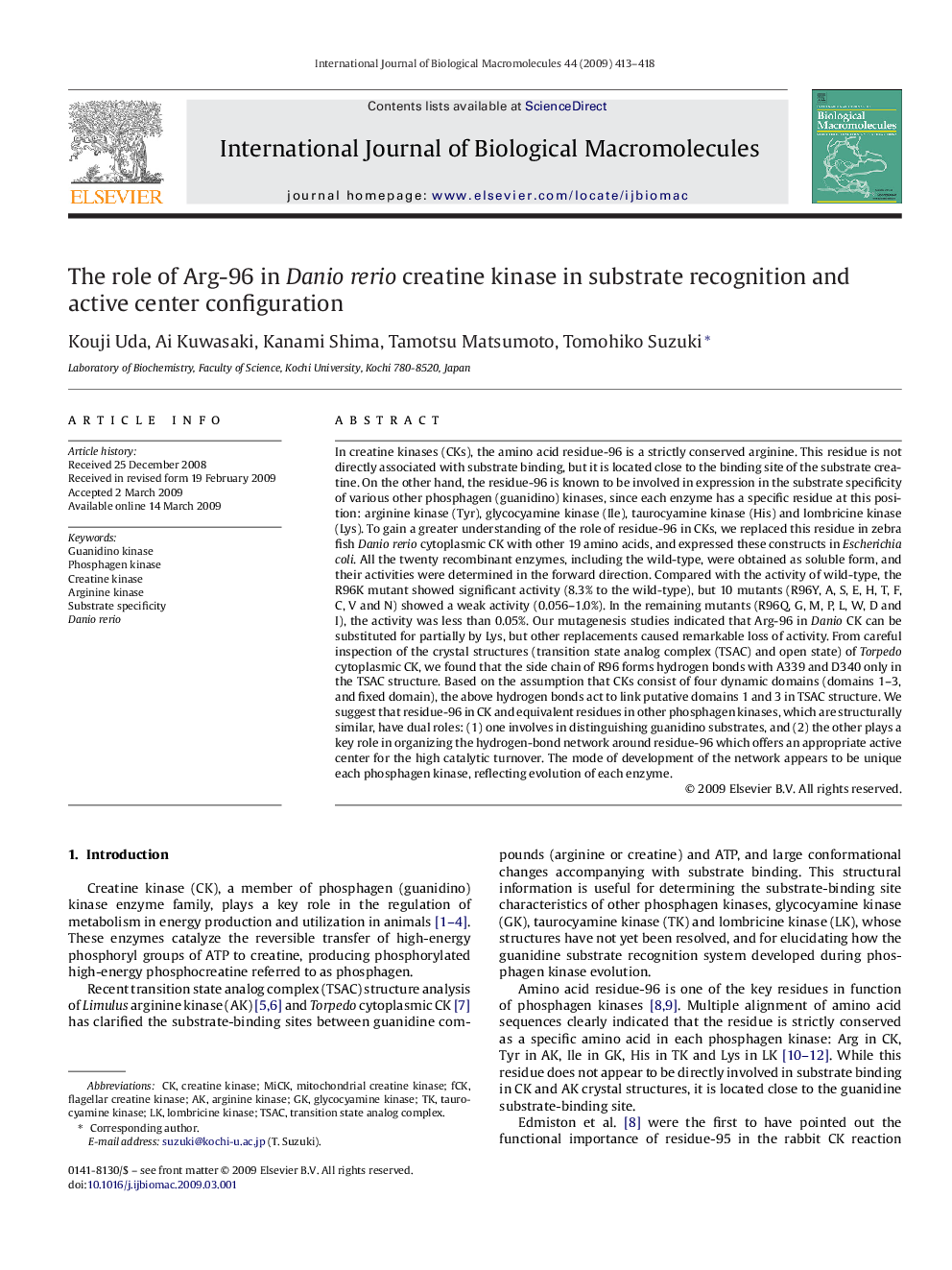| کد مقاله | کد نشریه | سال انتشار | مقاله انگلیسی | نسخه تمام متن |
|---|---|---|---|---|
| 1987985 | 1540303 | 2009 | 6 صفحه PDF | دانلود رایگان |
عنوان انگلیسی مقاله ISI
The role of Arg-96 in Danio rerio creatine kinase in substrate recognition and active center configuration
دانلود مقاله + سفارش ترجمه
دانلود مقاله ISI انگلیسی
رایگان برای ایرانیان
کلمات کلیدی
TSACGuanidino kinasefckArginine kinase - آرژنین کینازTaurocyamine kinase - تاوروسایامین کینازSubstrate specificity - خصوصیات زیربناییphosphagen kinase - فسفات کینازlombricine kinase - لومبریکین کینازCreatine kinase - کراتین کینازMitochondrial creatine kinase - کراتین کیناز میتوکندریglycocyamine kinase - گلیکوکسیامین کینازDanio rerio - گورخرماهی
موضوعات مرتبط
علوم زیستی و بیوفناوری
بیوشیمی، ژنتیک و زیست شناسی مولکولی
زیست شیمی
پیش نمایش صفحه اول مقاله

چکیده انگلیسی
In creatine kinases (CKs), the amino acid residue-96 is a strictly conserved arginine. This residue is not directly associated with substrate binding, but it is located close to the binding site of the substrate creatine. On the other hand, the residue-96 is known to be involved in expression in the substrate specificity of various other phosphagen (guanidino) kinases, since each enzyme has a specific residue at this position: arginine kinase (Tyr), glycocyamine kinase (Ile), taurocyamine kinase (His) and lombricine kinase (Lys). To gain a greater understanding of the role of residue-96 in CKs, we replaced this residue in zebra fish Danio rerio cytoplasmic CK with other 19 amino acids, and expressed these constructs in Escherichia coli. All the twenty recombinant enzymes, including the wild-type, were obtained as soluble form, and their activities were determined in the forward direction. Compared with the activity of wild-type, the R96K mutant showed significant activity (8.3% to the wild-type), but 10 mutants (R96Y, A, S, E, H, T, F, C, V and N) showed a weak activity (0.056-1.0%). In the remaining mutants (R96Q, G, M, P, L, W, D and I), the activity was less than 0.05%. Our mutagenesis studies indicated that Arg-96 in Danio CK can be substituted for partially by Lys, but other replacements caused remarkable loss of activity. From careful inspection of the crystal structures (transition state analog complex (TSAC) and open state) of Torpedo cytoplasmic CK, we found that the side chain of R96 forms hydrogen bonds with A339 and D340 only in the TSAC structure. Based on the assumption that CKs consist of four dynamic domains (domains 1-3, and fixed domain), the above hydrogen bonds act to link putative domains 1 and 3 in TSAC structure. We suggest that residue-96 in CK and equivalent residues in other phosphagen kinases, which are structurally similar, have dual roles: (1) one involves in distinguishing guanidino substrates, and (2) the other plays a key role in organizing the hydrogen-bond network around residue-96 which offers an appropriate active center for the high catalytic turnover. The mode of development of the network appears to be unique each phosphagen kinase, reflecting evolution of each enzyme.
ناشر
Database: Elsevier - ScienceDirect (ساینس دایرکت)
Journal: International Journal of Biological Macromolecules - Volume 44, Issue 5, 1 June 2009, Pages 413-418
Journal: International Journal of Biological Macromolecules - Volume 44, Issue 5, 1 June 2009, Pages 413-418
نویسندگان
Kouji Uda, Ai Kuwasaki, Kanami Shima, Tamotsu Matsumoto, Tomohiko Suzuki,